Understanding Education in Palestine and the Need for Educational Aid
Posted in: Programs
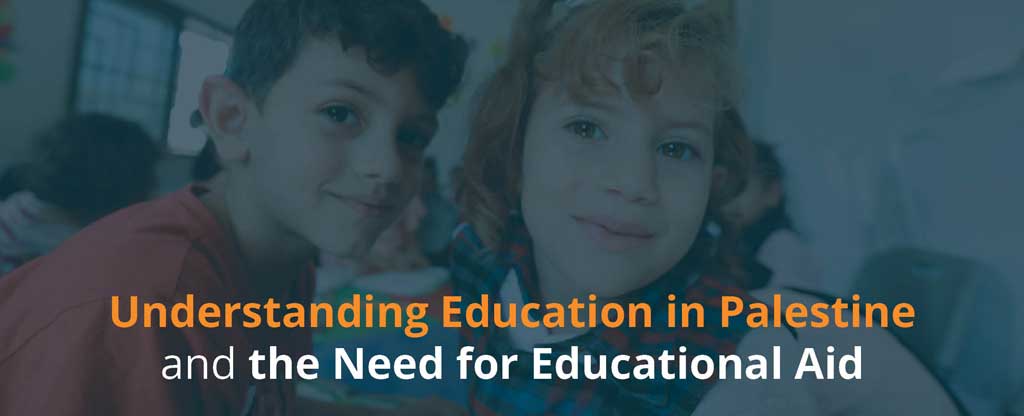

Most of us have school classes and teachers we look back on with great affection. They stimulated our imaginations, engaged our intellects and showed us a path forward toward achieving our dreams.
But many children around the world receive limited educational opportunities. The World Bank reports that 56 percent of children born today will lose half of their potential lifetime earnings because of a lack of access to quality education. Diminished access to education also results in a loss of the human capital that has helped many countries make great strides in economic development and the reduction of poverty.
In Palestine, where poverty, unemployment and political instability are high, education provides valuable tools for helping young people work toward a better life.
Background of the Palestinian Education System
The Palestinian Authority (PA) provides most of the public educational services in Palestine. The Palestinian Ministry of Education and Higher Education (MoEHE) is responsible for primary, secondary and higher education, plus technical training.
From 1948, with the establishment of Israel as a state, to 1967, Egypt governed Gaza, and Jordan governed the West Bank. Therefore, schoolchildren in Gaza studied the Egyptian curriculum, and schoolchildren in the West Bank studied the Jordanian curriculum. In 1967, when Palestine came under Israeli control, this situation remained unchanged, except for the censorship of certain materials.
In 1994, after the Oslo Accords and the formation of the PA and MoEHE, work began on the establishment of a Palestinian school curriculum. By the 2006–2007 school year, all classes in all grades were using that national curriculum in schools.
Infrastructure, Teachers, Materials and Electricity Shortages
Numerous difficulties persist across the Palestinian educational system, such as minimal school infrastructure, a shortage of qualified teachers and a lack of access to education. A shortage of textbooks and other essential supplies also hampers student learning. Due to the blockade currently in place against Gaza, many items such as books, pencils and the construction materials needed to build or rebuild schools cannot cross its borders.
Even when students have school facilities to go to and the proper materials to work with, the frequent power outages further impede student learning. For this and other reasons, almost half of Palestinian schoolchildren, no matter how diligently they try to keep up with their studies, fall short of international standards for student learning outcomes.
War and School Destruction
Many Palestinian schools in Gaza have been subject to violence and demolition at the hands of Israeli forces. One report found that bombings damaged 138 Gaza schools in the summer of 2014. These attacks left almost 330 children dead and over 2,000 injured. In many areas, schools closed for months because of the destruction. The 2014 conflict was not an isolated event — repeated bombings have periodically destroyed Palestinian schools.
Palestinian schoolchildren’s access to education continues to come under siege. Schools have been demolished or threatened with demolition, teachers have endured increased scrutiny at security checkpoints and students have had to contend with Israeli security forces on their way to school. In 2018, in the West Bank, the UN documented 111 such cases of interference with education — cases that affected more than 19,000 pupils.
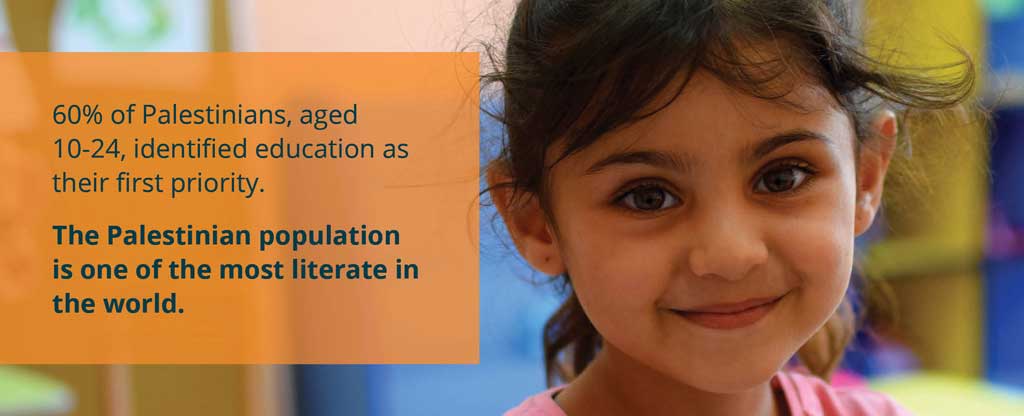

Enrollment and Literacy Rates
Despite the circumstances, school enrollment numbers in Palestine are high, with about a million Palestinian children attending school. The dropout rate among Palestinian schoolchildren is below one percent in primary education, though it rises to almost 2.5 percent in secondary education, with slightly more male students leaving school than females. Overall, these Palestinian education statistics show that Palestinian youth value education highly. One report found that 60 percent of Palestinians aged 10 to 24 identified education as their first priority.
Literacy rates also remain high. According to one study, the Palestinian population is one of the most literate in the world. The latest data shows a Palestinian literacy rate of 96.3 percent — a rate that well surpasses the average mark of countries that have attained “high human development,” which tend to have literacy scores ranging throughout the nineties. This high literacy rate indicates Palestinians’ hunger for education and demonstrates the good that educational programs have provided and can continue to provide in the region.
The Necessity of Improving Girls’ Education
Palestinian women have made great strides in literacy over the past two decades. The women’s literacy rate was 78.5 percent in 1995, but that rate has soared to a current level of 94.1 percent. Additionally, at the university level, girls’ enrollment matches that of boys, and girls are robustly represented in STEM fields as well.
However, girls’ education still has areas for improvement. A minority of Palestinian schools are coeducational, and overall, female students in Palestine tend to receive a lower quality of education than their male counterparts. Many male students go to private schools because their families expect them to become the primary breadwinners when they reach adulthood, often by working abroad. Female students, who are typically free from this expectation, do not receive the same educational opportunities. Families with limited resources tend to put most of their resources into their boys’ educations.
Especially in Gaza, where the unemployment rate is over 50 percent, the result is an astronomical unemployment rate among women — double that of men. The UN reports that most women who work in the public sector have minimal options, usually working in the fields of health or education. Outside the public sector, women have difficulty finding jobs that pay a living wage. Childcare, for example, might bring in only $100 a month. Women also take on unskilled work, such as domestic labor, cleaning and jobs on family agricultural operations, often for little to no pay.
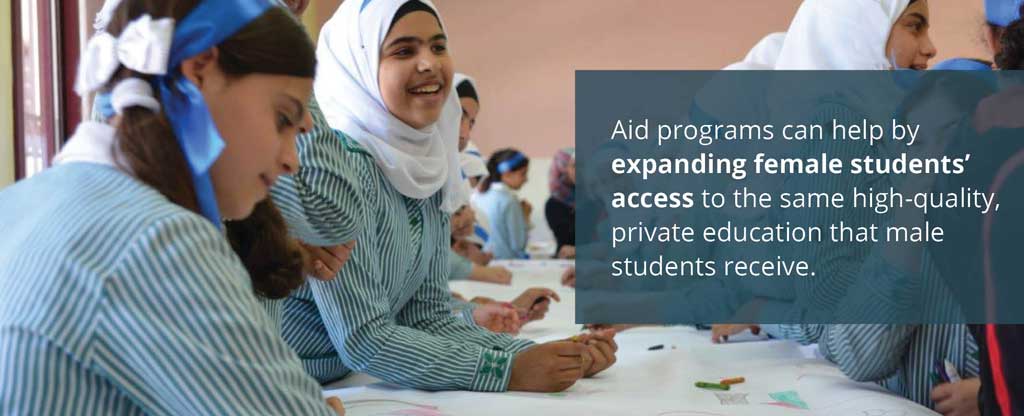

Aid programs can help by expanding female students’ access to the same high-quality, private education male students receive. They can help give female students additional skills that will allow them access to more employment options as well.
Improving the Current Shortage of Classrooms, Teachers and Administrative Staff
Millions of Palestinian children want to attend school, but the number of prospective students exceeds the number of bodies Palestinian classrooms can currently accommodate. A shortage of teachers and administrative staff only compounds the effects of limited classroom space.
Classroom Shortages
Particularly in Gaza, school overcrowding is a major problem. More than half a million children attend school in overcrowded classrooms. Two-thirds of schools must operate on double shifts to squeeze in as many students as possible, and a few operate on triple shifts. Under these educational models, students can only attend school for only a few hours per day, instead of for full days, or they must be at school late into the evening, even past the dinner hour.
Even when classrooms exist, their condition makes for a challenging learning environment. Many classrooms have no temperature controls and little insulation against heat or cold. Additionally, an intermittent electrical supply sometimes means students must study in unlit classrooms and finish their homework by candlelight. Gaza currently receives only around 12 unpredictable hours of electricity per day, and the West Bank also experiences frequent electrical outages.
Teacher and Administrative Staff Shortages
In addition to classroom deficits that number in the hundreds and thousands, Gaza also experiences a shortage of 800 teachers and administrative staff members. The Hamas government that came to power in 2007 resulted in job loss for many Palestinian teachers, and the profession still has not fully recovered. Currently, there is no budget to cover substitute teachers when regular classroom teachers are on maternity leave or absent for other reasons. Additionally, some teachers do not come to school because they do not have money for transportation. Some do not receive their salaries, and some in the West Bank experience harassment and threats at checkpoints.
Aid groups in Palestine can help alleviate the teacher, staff and classroom shortages by funding additional educational programs. Additional educational programs would open up new classrooms in which students could learn in a safe, supportive environment, and they would provide steady jobs and salaries for teachers. By funding infrastructure projects to help rebuild damaged schools and increase the amount of temperature control and electricity that classrooms reliably receive, aid groups can also help create a more inviting environment for teachers and other staff members to work in.
The Particular Importance of Early Childhood Development
Early childhood development (ECD) is defined as programs and services for parents and children from conception to eight years of age in the field of education, health, nutrition, protection, and sanitation. ECD also refers to the holistic development of the child (including cognitive, social, emotional, and physical), which is most profound in the earliest months and years of life – a period considered the most important developmental phase in the human lifespan. Recent research in brain development suggests connections between early learning and academic success in later years.
While the Palestinian Ministry of Education has made significant progress over the past two decades in areas such as school building, recruitment of teachers and curriculum development, investment in the preschool education sector has been modest. Today, Anera estimates that less than 50% of preschool-aged children access preschool education. There are 2,017 kindergartens serving 148,253 children in the West Bank and Gaza. The private for-profit and charitable sectors are the main providers of preschool education in Palestine. Anera’s assessments have found that 75% of kindergartens are deficient in terms of space, facilities, learning materials and resources. Preschool teachers and supervisors are under-trained and poorly paid with few professional development opportunities. Most preschools (both for-profit and charitable) are fee-charging, making access a serious constraint for most families. Furthermore, parents and caregivers have limited knowledge of the care and developmental needs of their children. This is particularly important as poverty, the political environment, and community violence adversely affect young children, especially in Gaza.
Reducing Educational Stress and Anxiety
Between the inhospitable classroom conditions, financial strain at home, bombings and violence in the community, Palestinian children are under a significant amount of stress and anxiety.
One report found that after the war in Gaza in 2008-2009, between 14,000 and 28,000 children required psychological intervention to address their resulting long-term trauma. The loss of parents and other family members, disruption of daily life and inadequate nutrition all contributed to psychosocial distress among children.
UNESCO reports that learners of all educational levels experience increased nervousness, sadness and fear of attack in a volatile environment such as the one experienced in Palestine. Children’s resulting inability to concentrate leads to decreased performance in school and poor retention of material. Teachers and school support staff members experience significant disruption to their psychosocial well-being as well.
These factors also contribute to psychosocial distress among children, even in the absence of immediate hostilities. Military occupation, political instability, violence, poverty, family unemployment and lack of adequate food, heating and shelter make it difficult for children to concentrate in school because of astronomical stress levels.
Though aid programs cannot hope to resolve all these issues, they can be forces for positive change and hope for young students. A cheerful, well-supplied classroom with a message of hope and encouragement helps give students a secure place to relax and learn for a few hours. Aid programs can also help train teachers in therapeutic techniques to help students cope with their stressful environment.
Fostering a Healthy Educational Environment of Stability
Because many Palestinian children experience high levels of stress and anxiety, it’s vital for the classroom to provide a stable place where students can thrive. The comforting ritual of going to a positive and inviting school can be critical for Palestinian youth.
Anera has focused many of its efforts in the past decade on fostering healthy and stable educational environments for preschool-aged children. Our early childhood development program promotes learning at an early age to help young children get a supportive start, despite their tumultuous surroundings. We improve preschool classrooms, train teachers, supply needed resources and incorporate creative instructional elements like arts and drama to help children process and cope with their surroundings. We also train parents in positive-parenting methods to help them extend the program into their homes.
We have recently built eight new preschools across Palestine, providing hundreds of young Palestinians with the opportunity to learn in safe, caring and enriching environments. Anera has either built or renovated 208 preschools in Palestine, so even the youngest learners have a stable place to go to school.
Since 2003, Anera has also constructed, added classrooms to, or renovated 68 primary and secondary schools in Palestine. Our interventions created more learning space, improved facilities for children with disabilities, upgraded water and sanitation systems, added new technologies and libraries, and built new schools where none existed before.
In Jerusalem, we recently provided therapy and learning facilities for students with special needs at the Princess Basma Center. All children, no matter their abilities, deserve a healthy, supportive environment in which to grow, and thanks to our work, more than 600 special-needs students have gained just that.
Why Educational Aid Matters
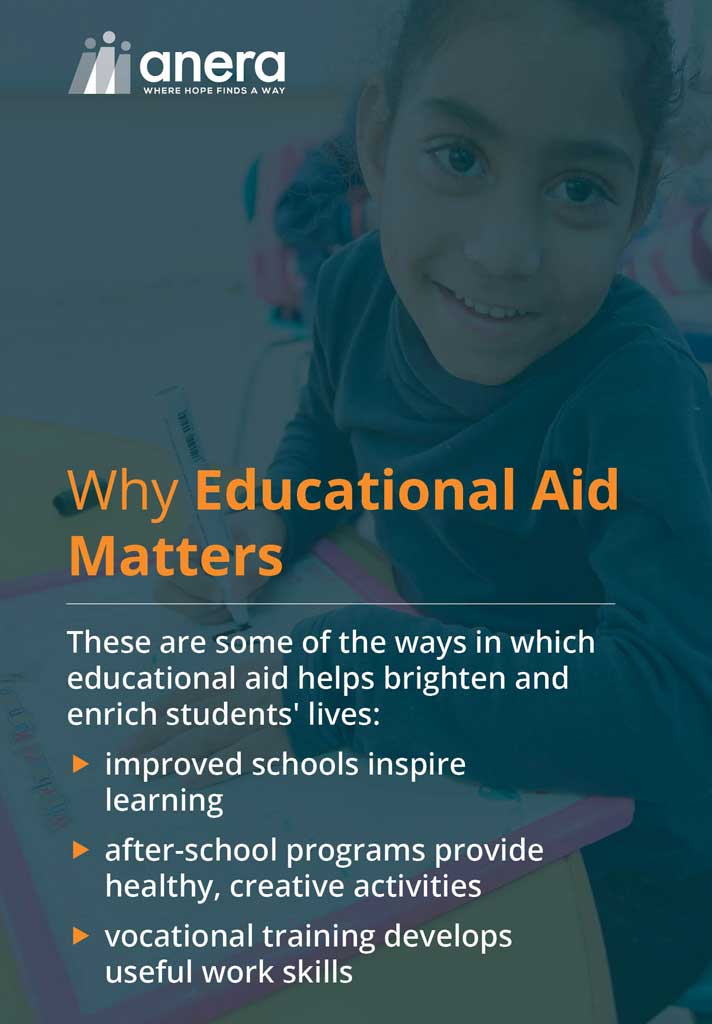

Educational aid matters because the future of Palestinian children matters. Young Palestinians should have the opportunity to learn and grow, enrich their communities, provide financial security for their families and strive to bring positive impact to Palestine in the coming years. Educational support will be invaluable in helping them reach their goals.
Here are some of the ways in which educational aid helps brighten and enrich students’ lives:
- Improved infrastructure: Educational aid helps improve school infrastructure, so students have safe, functional spaces in which to learn. Educational aid can help provide the needed supplies and fund repairs and new construction.
- Teacher training: Educational aid helps equip teachers with the skills and knowledge they need to create a stimulating and fulfilling learning environment. Training can also be coupled with intensive mentoring so teachers are supported as they put to practice the new skills they have learned.
- Enriching after-school programs: Educational aid helps provide enriching after-school programs to extend children’s learning beyond the formal classroom. Arts and culture programs, in particular, help children engage with the creative sides of their personalities to learn, express themselves and work through the challenges they face in their day-to-day lives.
- Vocational skills: Educational aid also offers vocational training. Vocational training helps students develop the skills they will need to secure jobs in a severely limited workforce and provide much-needed income for themselves and their families.
Perhaps most importantly, educational aid helps give students and their families hope. It helps students unlock their potential and provides them with the tools they will need to make positive changes in their communities. Educational aid programs believe and invest in young people and, at their best, they help young people believe and invest in themselves as well.
Donate to Anera to Contribute to Educational Aid
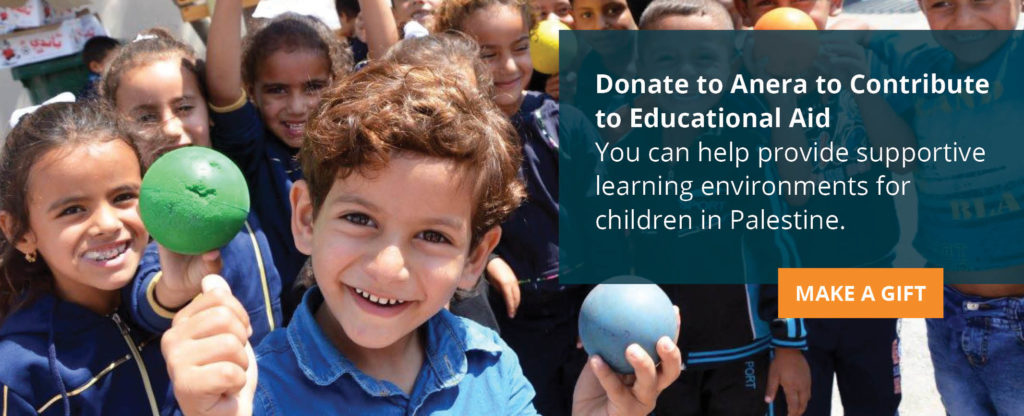

For half a century, Anera has brought hope and purpose to vulnerable communities in Palestine and around the Middle East.
Our educational aid programs are a cornerstone of our development efforts. Education is the key to personal and community empowerment, and we strive to help communities in Palestine by using educational services to foster knowledge, growth, security, good health and the vision to work toward a brighter future.
You can help provide supportive learning environments for children in Palestine. Make a gift to Anera today to help make a difference through educational aid.
OUR BLOG
Related
Part of a series on the impact of the war on all sectors of economic life within Gaza, Anera’s immediate response and plans for the future. Other posts cover housing, education, WASH, health and food production systems. Livelihood Recovery In Gaza, 57 years of occupation and…
InterAction and 50 Member CEOs, some of whom have organizations that work in Gaza, urge President Biden to take decisive and actionable steps to alleviate the humanitarian crisis in Gaza. Detailed within this letter are specific steps and commitments that…
